Talking Blackness with Marianetta Porter
In spring 2016, GalleryDAAS, the art gallery of the Department of Afroamerican and African Studies (DAAS) at the University of Michigan, presented Color Code, an exhibition of work by Stamps Professor Marianetta Porter, curated by Stamps Professor Franc Nunoo-Quarcoo.
In Color Code, Porter explored the conundrums and complexities of the color question, exploring the codes (social, racial, legal, etc.) that frame racial identity and define blackness in our everyday lives. The exhibition was accompanied by a full-color catalog, featuring work from the show, essays, and a conversation between Marianetta Porter and David T. Doris, Associate Professor in the U-M Department of the History of Art, the Department of Afroamerican and African Studies, and the Stamps School of Art & Design at the University of Michigan.
Portions of Marinetta's conversation with David T. Doris are reprinted here with permission. The catalog can be purchased from the University of Michigan Museum of Art store.
Marianetta Porter: Ideas for the Color Code exhibition began with a quote from Hélène Cixous: “I say blackness and not: black. Blackness isn't black. It is the last degree of reds. The secret blood of reds. There are so many blacks… Twenty-four, they say.”[1] Cixous's words refer to the darkness in Rembrandt's painting, Bathsheba at Her Bath (1654).
David Doris: What about the phrase compelled you?
The mix of black and red and blood and secrets. “There are so many blacks…Twenty-four, they say.” Who is the “they”? Why twenty-four? That quote raises so many questions. It made me think of the relationship of Africans, African Americans and Native Americans; psychologically, we are connected through blood. Not just in genetic terms, but also in the blood we spilled making this empire we call America. Our blood was the mortar for those building blocks. There's a shared history.
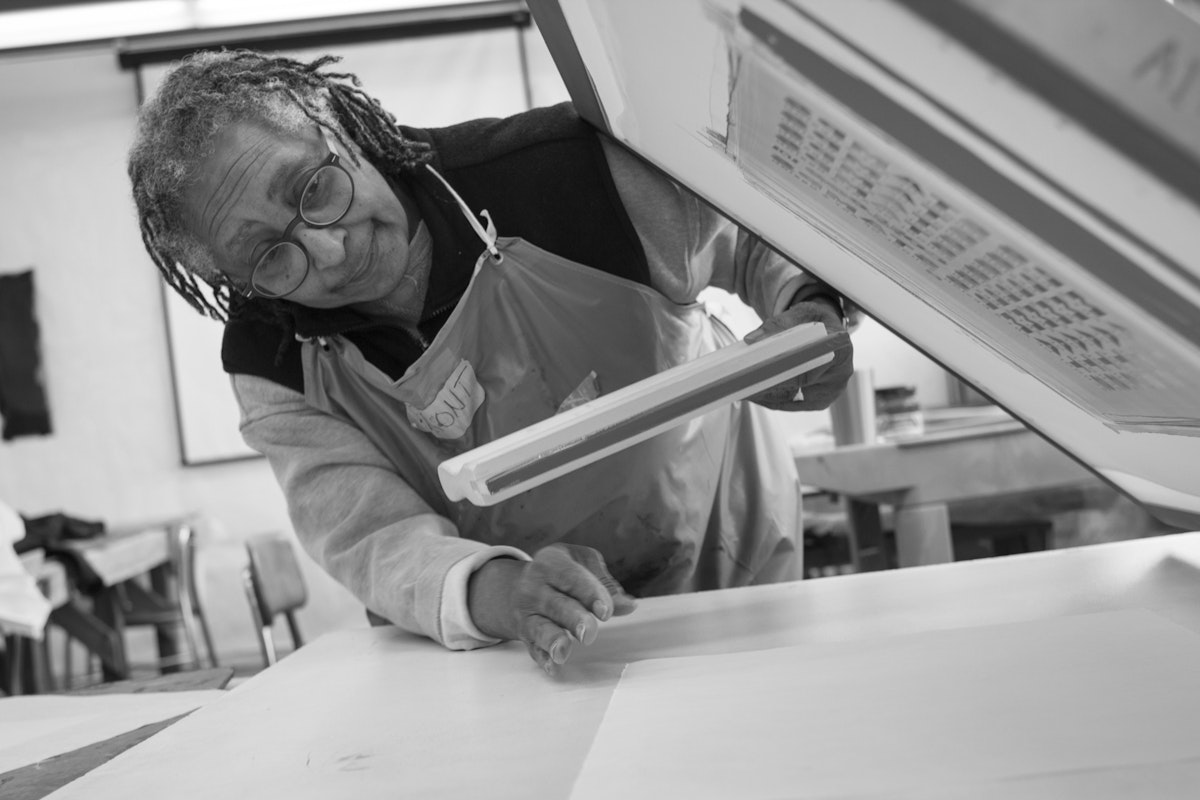
Rembrandt could hardly have reckoned with that. So he's using twenty-four different blacknesses in his work?
Perhaps. As you know, the principle of simultaneous contrast tells us no color is ever true or pure color; we read it only in relation to another color, in context. If you put one color against another color, it may seem warmer or cooler or lighter or darker. In some ways, blackness itself has that kind of slippage.
So, the blackness of the color black is that it is many colors. I'm wondering how the coloring of surfaces relates to a “racial” conception of blackness, which you seem to suggest is also diverse.
When we talk about blackness, we immediately think of surface: the epidermis, the amount of melanin in someone's skin, how dark or light they are. But blackness goes far deeper than the skin. Certainly within the history of this country, there are very light-skinned people who define themselves as black. So what makes a black person black beyond skin color, beyond the surface?
Is blackness a color, then, or a set of relationships? You're speaking to a kind of epidermal diversity among people who are, in one way or another, related to this notion of blackness. What unifies them as “black”?
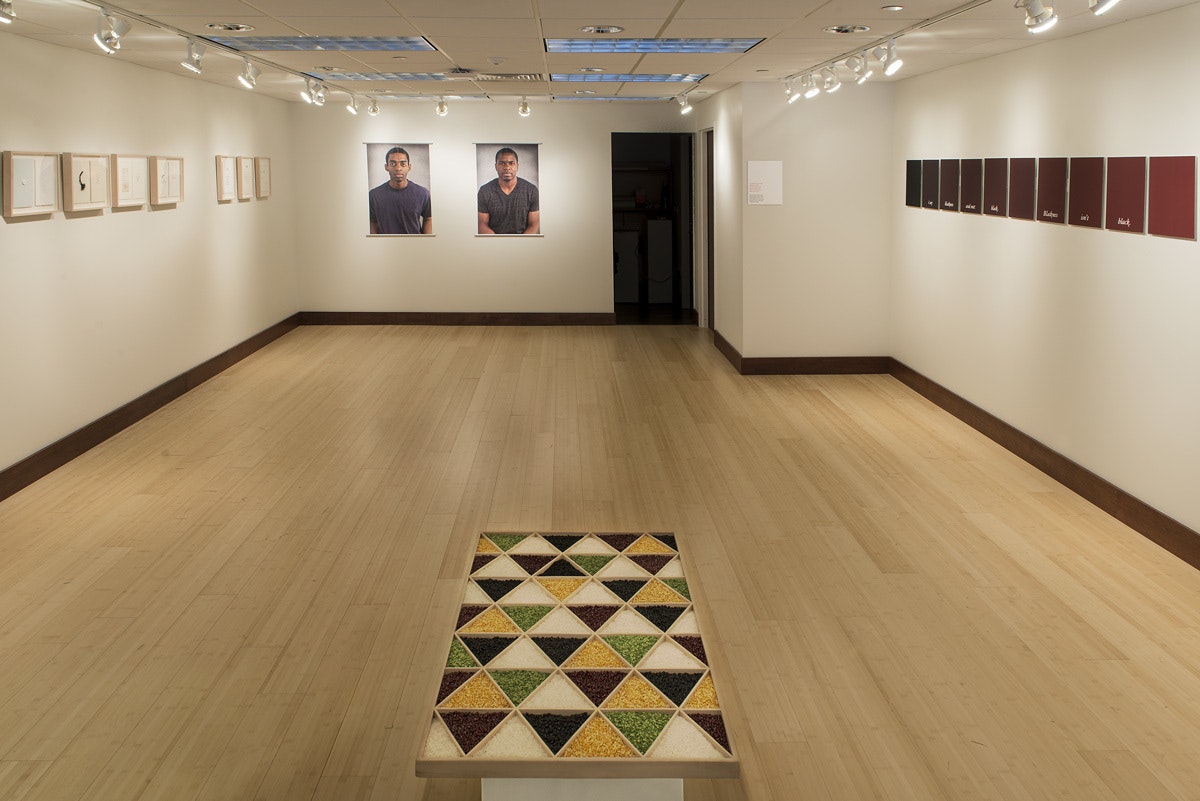
My work remains grounded in the study of African American history, culture, and representation. For me, the work has been wrapped in the stories and history of what I've called the black experience. This new body of work, however, marks a shift in my thinking; it's less about the black experience, and more about the experience of blackness. DuBois' concept of “double consciousness,” Ellison's notions of invisibility, these are still part of our landscape today. In literature and the arts the idea of “post-blackness” is increasingly important. What is “authentically black,” particularly when there is no single, common “black experience”? So much of African American history has been tied to the Middle Passage, but what does it mean today when an African cab driver and a black cab driver from Harlem talk about their blackness? What is “authentic”? Is Obama “black” or not? With increasing numbers of mixed-race people, the diasporic influx of black- and brown-skinned people from around the world, “black” experiences don't just arise out of the Middle Passage. So how do we think about blackness today?
Recent immigrants from Africa, even with their green cards in hand—are they “African American”?
It's a fascinating time to ponder these conundrums.
Oh yes. So here's a timely conundrum. Last summer there appeared a face — regarded as a black face, or not — that belonged to a certain Rachel Dolezal. That face generated a lot of intense commentary, reaction, reflection, regarding what constitutes “authentic blackness” — genetic, historical, or cultural. Self-identification and performance were key. Dolezal associated herself with blackness at so many different levels, embraced it as hers. Was it ever hers? Was it not? Was the masquerade necessary so she could get over? Or was it somehow the expression of a deeper self, as masquerades often are — a fuller self that couldn't otherwise be expressed? Genetics may not have figured into the mix, but cultural performance did. So many individual associations of what constitutes some sort of a core “black” cultural experience. Is there one?
In the '90s Robert Douglas wrote an article in New Art Examiner called “Formalizing an African-American Aesthetic.”[2] He talked about aesthetics and the expression of blackness in music, dance, performance, speech, literature, and the visual arts. He speculated that if there were one thing that might be considered a predisposition, it would be in what he called the presence of “multi-dominant elements within a single composition.” In music it's a poly-rhythmic cadence, achieved through the superimposition of several lines of meter. In dance, it's the ability to move individual parts of your body to distinctly different rhythms. In the visual arts, it's a tendency to use multiple textures, patterns, colors, and shapes, all together. And in language and storytelling, the multiple meanings embedded within a single text are revealed through elaboration or embellishment, more and more layers…
So one thing is also many, opens up to expansion and intricacy. Zora Neale Hurston spoke of it as “decorating the decoration.”[3]
Yes! There's improvisation, taking a refrain and embellishing it, adding, exaggerating, distorting it. Douglas speaks of call-and-response dialog; a congregation doesn't just sit back and listen to the preacher, they talk back to him, he returns their response, an elaborated conversation. The same with storytelling: communal response is expected, even encouraged.
Layerings across space, for sure, and also through time. Puts me in mind of Hurston's efforts to codify the “Characteristics of Negro Expression” in the 1930s; as well as Richard Waterman's article of the late 50s, where he traced similar characteristics in music, in both African and African American contexts.[4] Later, Robert Farris Thompson used these to outline some underlying tendencies of a “Black Atlantic Visual Tradition.”[5] Critical questions have arisen around whether this is some kind of essentialism.
I've been reading Physics of Blackness, by Michelle Wright.[6] She talks about a shifting of consciousness regarding what is black within contemporary contexts. My students' notions of blackness certainly don't mirror mine or my parents.' The boundaries are loosening, falling apart — for good or for bad.
There's a demand for those bonds to be loosened, an expression of ongoing frustration. Touré's book on post-blackness, for instance, calls black Americans to move beyond constraints or expectations of what has constituted blackness.[7] There's no prescription, no compelling reason for blackness to be performed at all, let alone in any particular fashion. Instead, infinite possibilities of expression — the desire for liberation, always, but inevitably constrained within its political moment, its historical circumstances.
We can go back for a moment to Robert Douglas's African American aesthetic, which we agree not all African Americans share. It's an observation of expressive tendencies; some would say affirming a sense of shared African American identity over time. Where do you locate yourself in relation to this whole spectrum of black possibilities?
There are always multiple meanings that can be ascribed to any piece I make — it depends on who's looking at it, reading it. There are references to black history, black culture, outside knowledge, and inside understanding — where the viewer is coming from shapes the work.
So you include many possibilities, layers, within each work. Would you give an example from the works in the exhibition?
I have constructed a series of diptychs, pairing everyday objects with short text reflections. The objects come out of my personal narratives, and are also tied to collective histories and cultural knowledge. One composition is titled Hot Comb. The object is the lid to a can of Royal Crown pomade. For some viewers, it may recall memories of sitting in the kitchen, getting their hair straightened, listening to “women's talk,” a simple domestic experience. For others it may recall notions of a royal crown, an important code word, with multiple meanings in black culture.
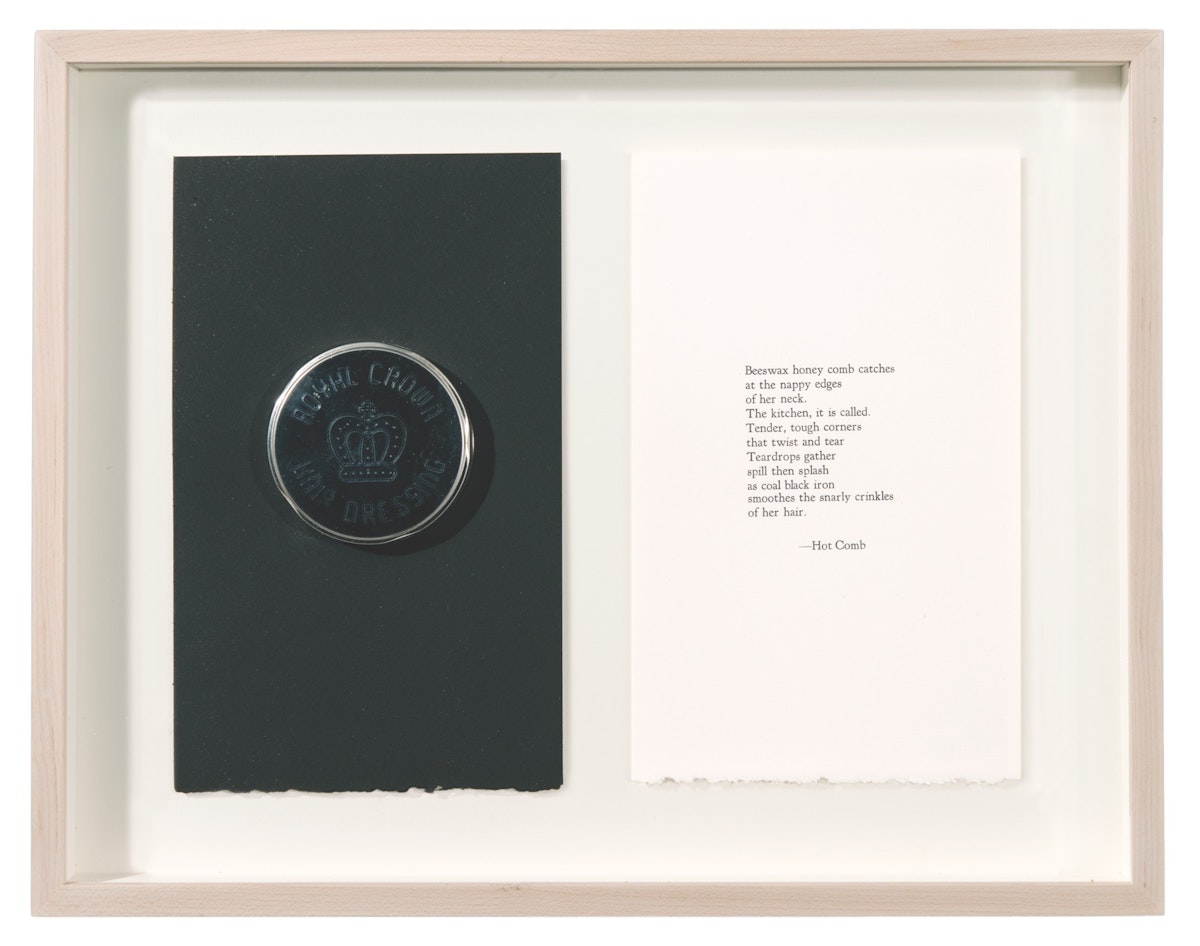
Shani Peters recently did an exhibition at GalleryDAAS celebrating the crown as a potent image in black cultural history. So, in these diptychs, the text and image together constitute the work?
Yes, the text accompanying Hot Comb reads:
Beeswax honeycomb catches/ at the nappy edges/ of her neck / the kitchen it is called / tender, tough corners/ that twist and tear / teardrops gather/ spill then splash/ as coal black iron smoothes the snarly crinkles/ of her hair
Now the kitchen is both a physical structure, the room where you get your hair styled; and in black culture, a code word for the nape of the neck, where the hair is nappiest. Henry Louis Gates Jr. has written an essay called “In the Kitchen” that talks about our attention to and obsession with “good” hair/“bad” hair.[8]
In many cultures, the nape of the neck is a notorious erogenous zone, where things get, you know… heated up. Concealing it and revealing it can be quite a big deal.
Yes! In times when women got their hair straightened with a hot-comb, when you started to sweat, when the body heated up, the first place the hair would revert to its natural state would be “the kitchen.” Heat in the kitchen, could be!
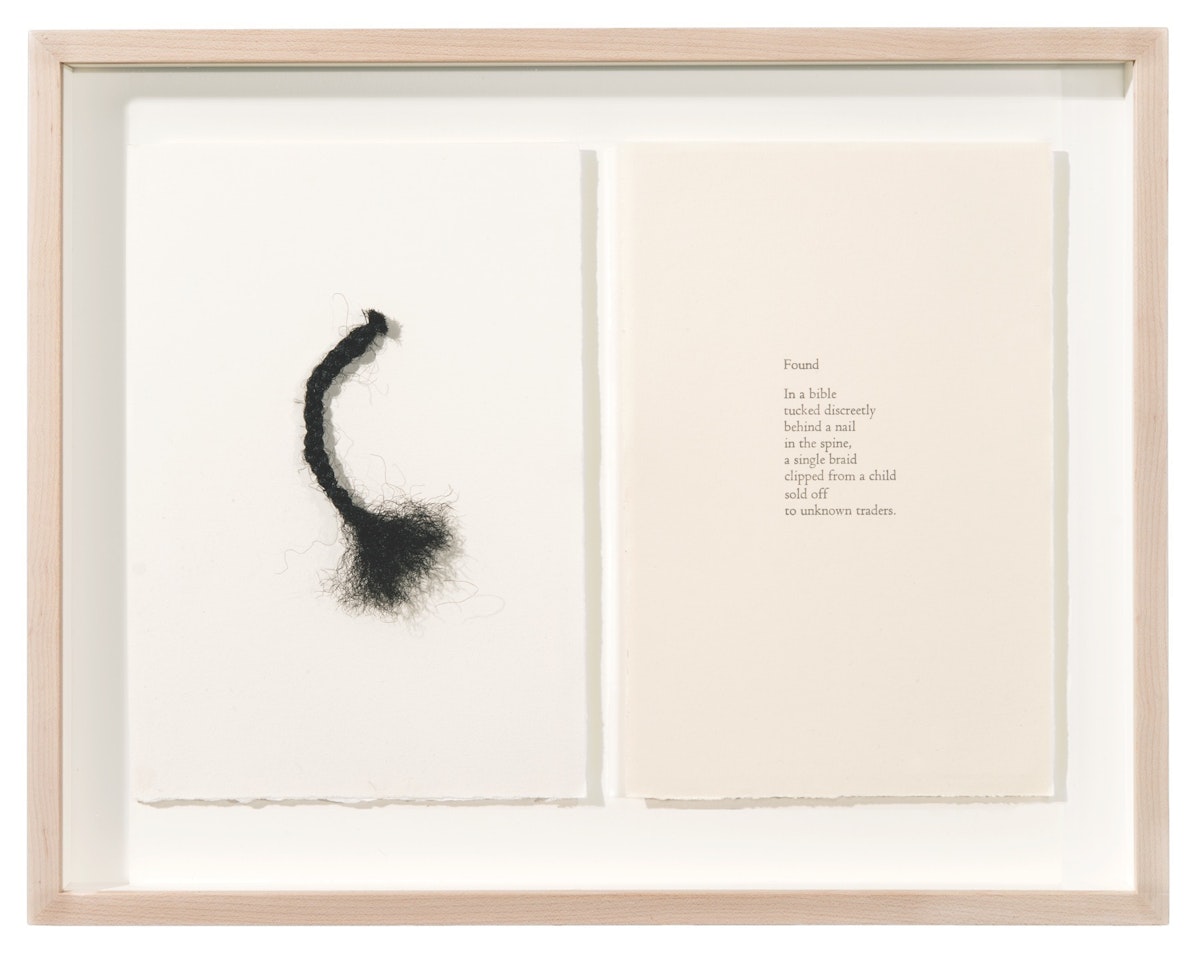
Another is titled One Drop Period. The words “one drop” appear on one page, and a red period floats in the middle of the opposite page. On one hand, One Drop references the legal code asserting that one drop of sub-Saharan African blood classified you as black. But it also speaks at the level of scale, of measurement — how things become significantly this or that. One drop, floating in a sea of whiteness. Though the drop is red, it relates to the notion of blackness. And that drop is not just a drop, it's a punctuation mark, a period, the definitive end to a statement.
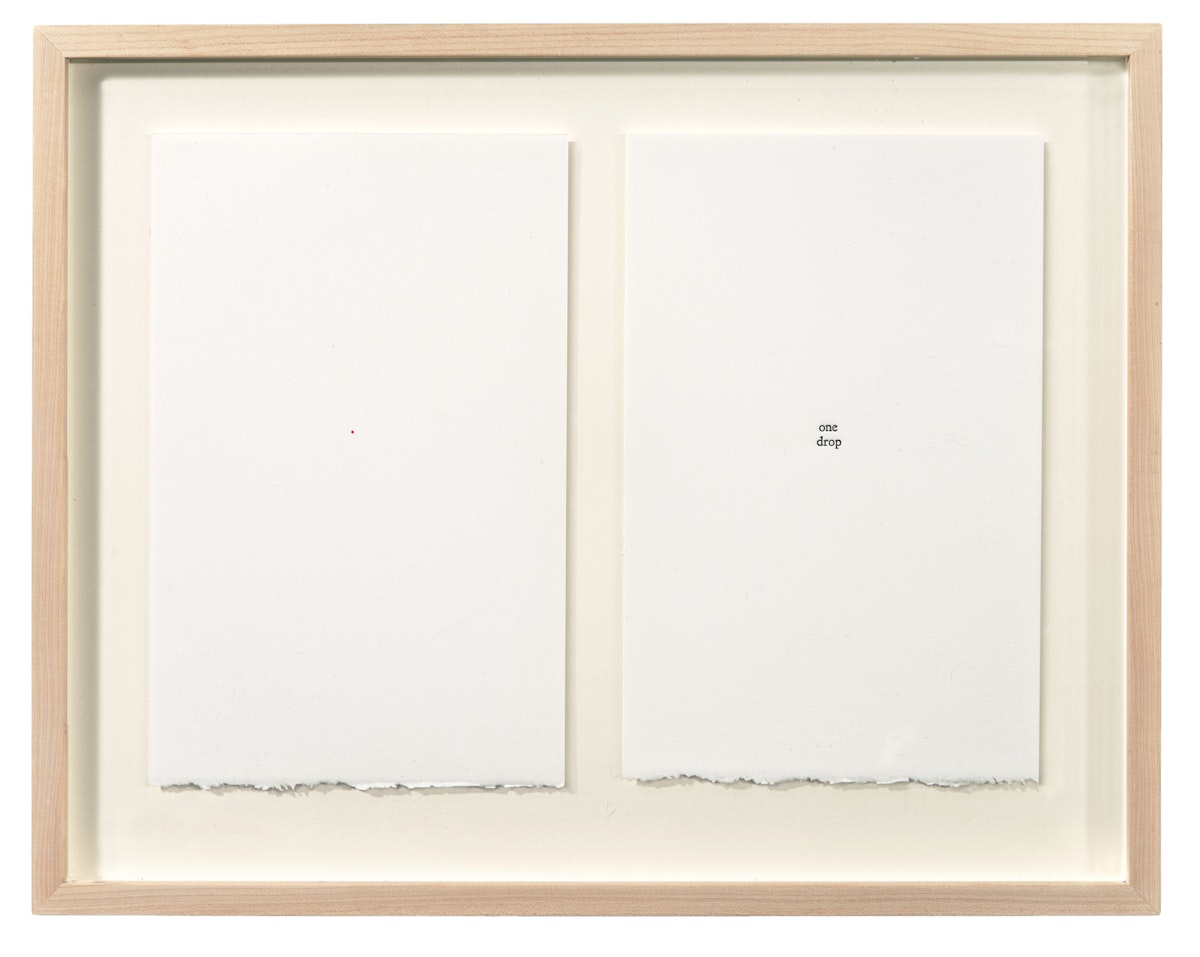
It refers us back also to the history of concrete poetry, too; words as material things exemplifying the very concepts they express. A period, as you say, is a stopping point. The title of the work includes a period after the words “one drop,” but in the work itself the period is dissociated from the words, floating, as you say. How does this drop function then as a period?
The period, made by letterpress type, is very carefully inked and then embossed into the paper. It is literally a period, yet disconnected from the letterforms on the opposite page. A period signifies the end of something, a boundary. But if we think about codes of blackness, is there a definitive stopping point or boundary?
Since we're talking about red and black, let's return to this scale you've established, with black as the superlative red, “the secret blood of reds.” In Blackness, panels of reds engage with each other. Each panel, regarded in isolation, is a stopping point; but together they are moments within a spectrum.
When you move from black to red, you establish the range of browns in between. This is a subtle reference to skin color: between the blackest black and the reddest red, there is a slippery slope that moves beyond skin color as a defining element.
In that scale of black and red you establish, white comes in — or doesn't come in — as a third element. It's excluded, in a way. It's interesting: mixing red with black really produces a convincing range of approximate skin-tones.
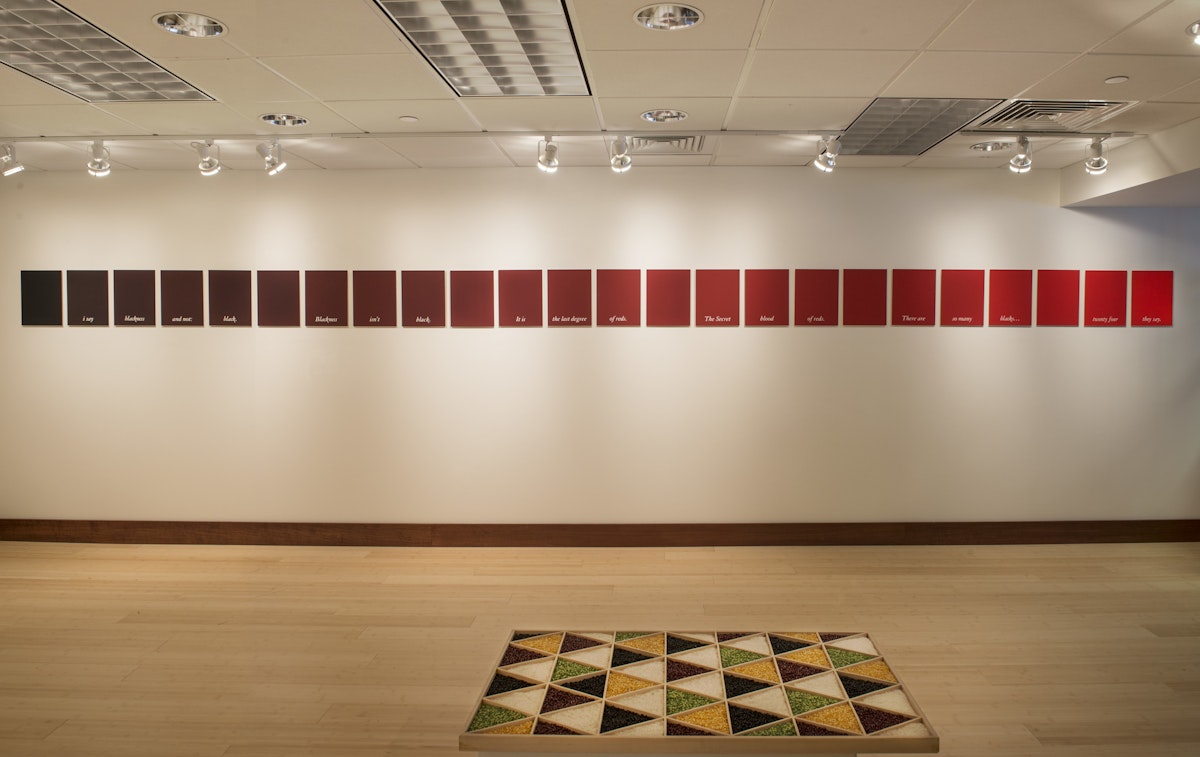
Yes, visually as we move along the spectrum, black becomes brown, brown becomes red, and metaphorically red becomes blood — a measure of one's whiteness. So there is no white in the panels, but it's implied, unspoken, floats like a ghost at the edges of the piece.
What's visible and invisible? What's spoken and unspoken? Two human-scaled portraits of young black men. If you look at the faces directly, they're simply portraits. But look at them from an angle, askew, and text becomes visible. These Presence of Absence portraits address invisibility, being at once here and not here, physically present but not perceived — like Ellison's Invisible Man. To view the text, you must step to the side. Sidestepping is a particularly human gesture we make when we're assessing a situation, especially one perceived as dangerous. These text-portraits implicate you, the viewer, obliging you to reflect on your own predispositions and automatic assumptions.
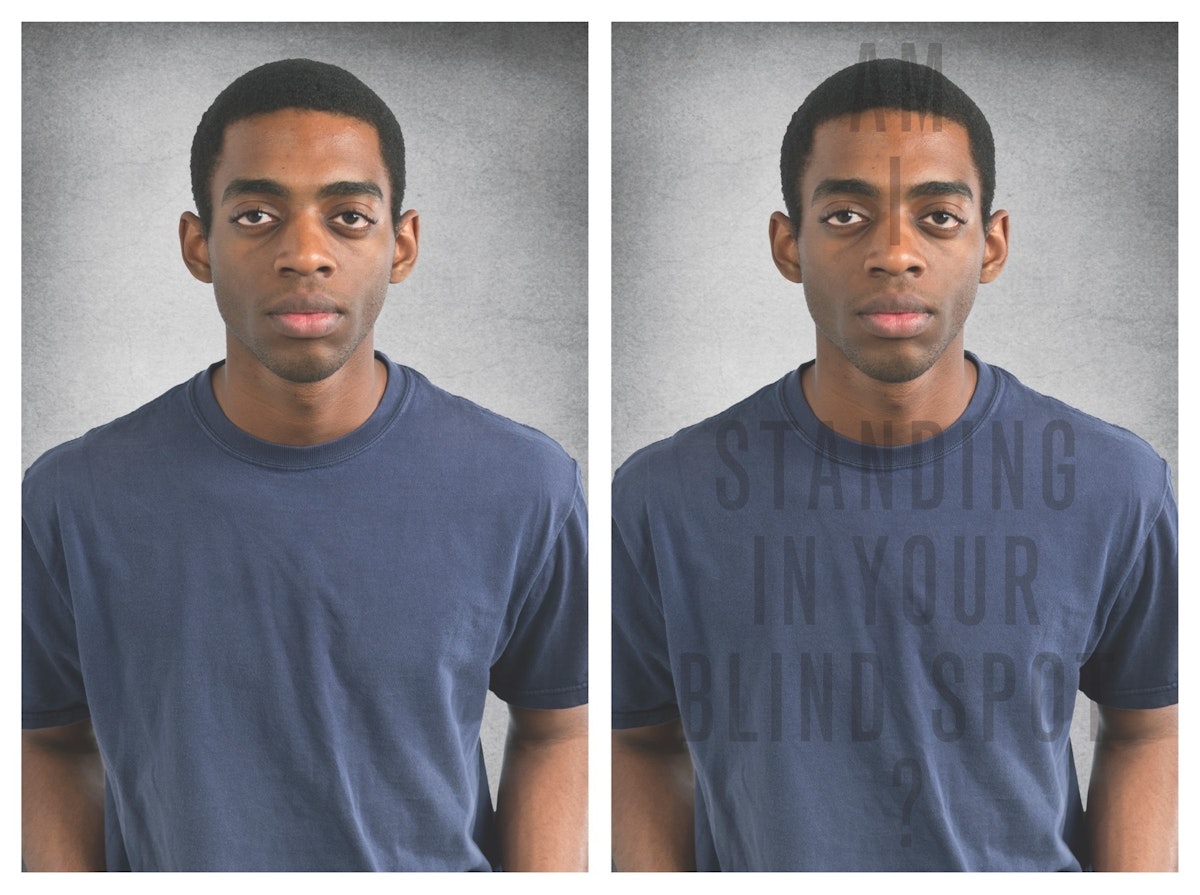
So blackness, as you've been addressing it, is a kind of code, or a set of codes. There are codes of behavior, codes of thought, codes of appearance, gesture, even codes of sound, which are enacted and are readable. And blackness as a code appears in relation to other codes, most typically the unspoken, “neutral” codes that comprise whiteness. There are levels to which those codes are meant to be secret, interior; but they are also the calligraphy, if you want, by which communication is established with an “outside.”
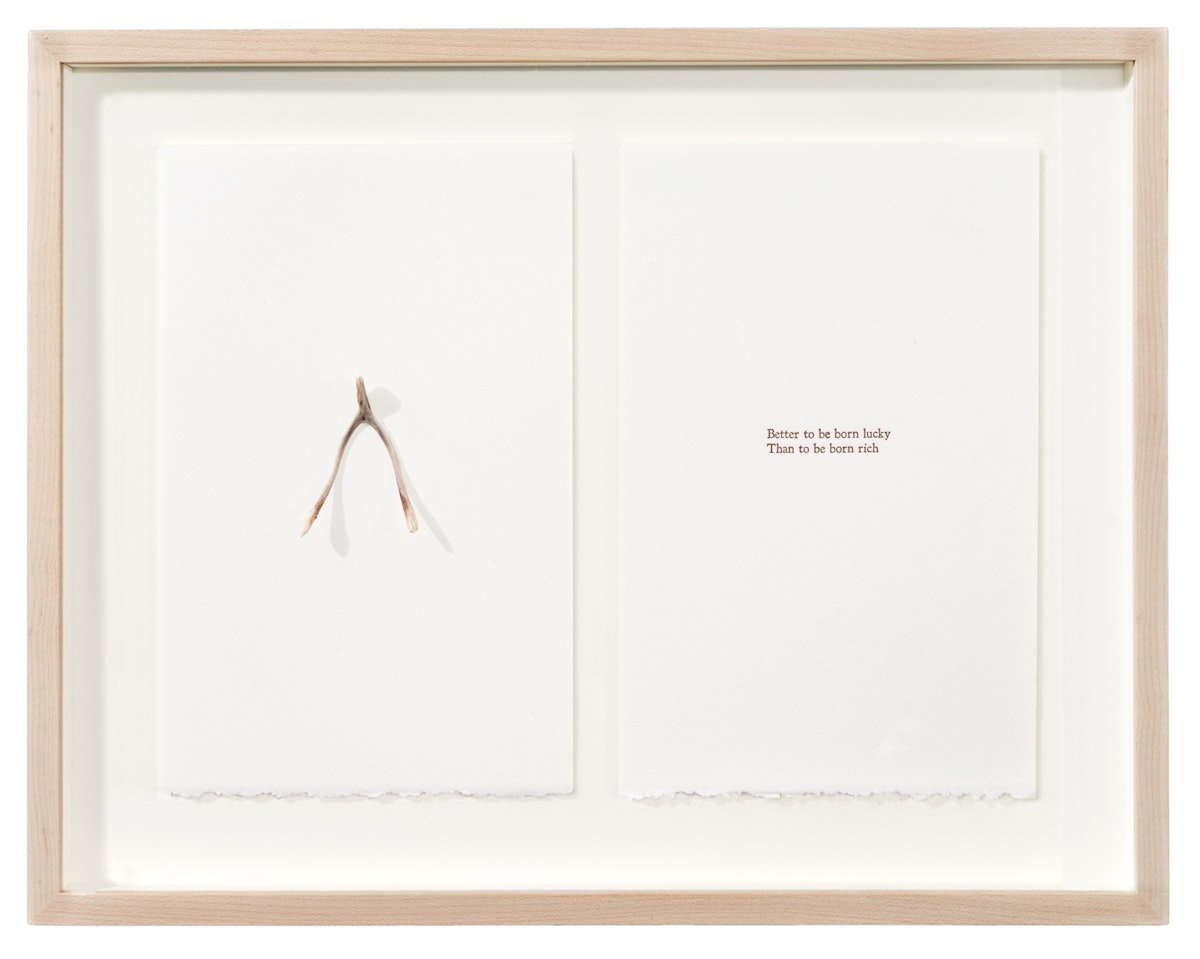
There are cultural codes, understandings expressed in gesture, speech patterns, rhythms. There are codes that relate to regulations, rules placed by a dominant culture on people determined to be “black.” There are also self-regulatory codes understood within the black community. For instance, “the N-word” is deeply coded.
Navarone? Nice? Nefarious?
The word “nigger.” Episode 1 of the second season of the television show Blackish was all about that word — who can say it, who can't say it, in what contexts can it be said. Almost any black person can say it, except a black cop. It never should be spoken in mixed company. Certain brown people can say it but others can't. As black people, we use codes to regulate and measure ourselves, to define people, to regard our racialized selves.
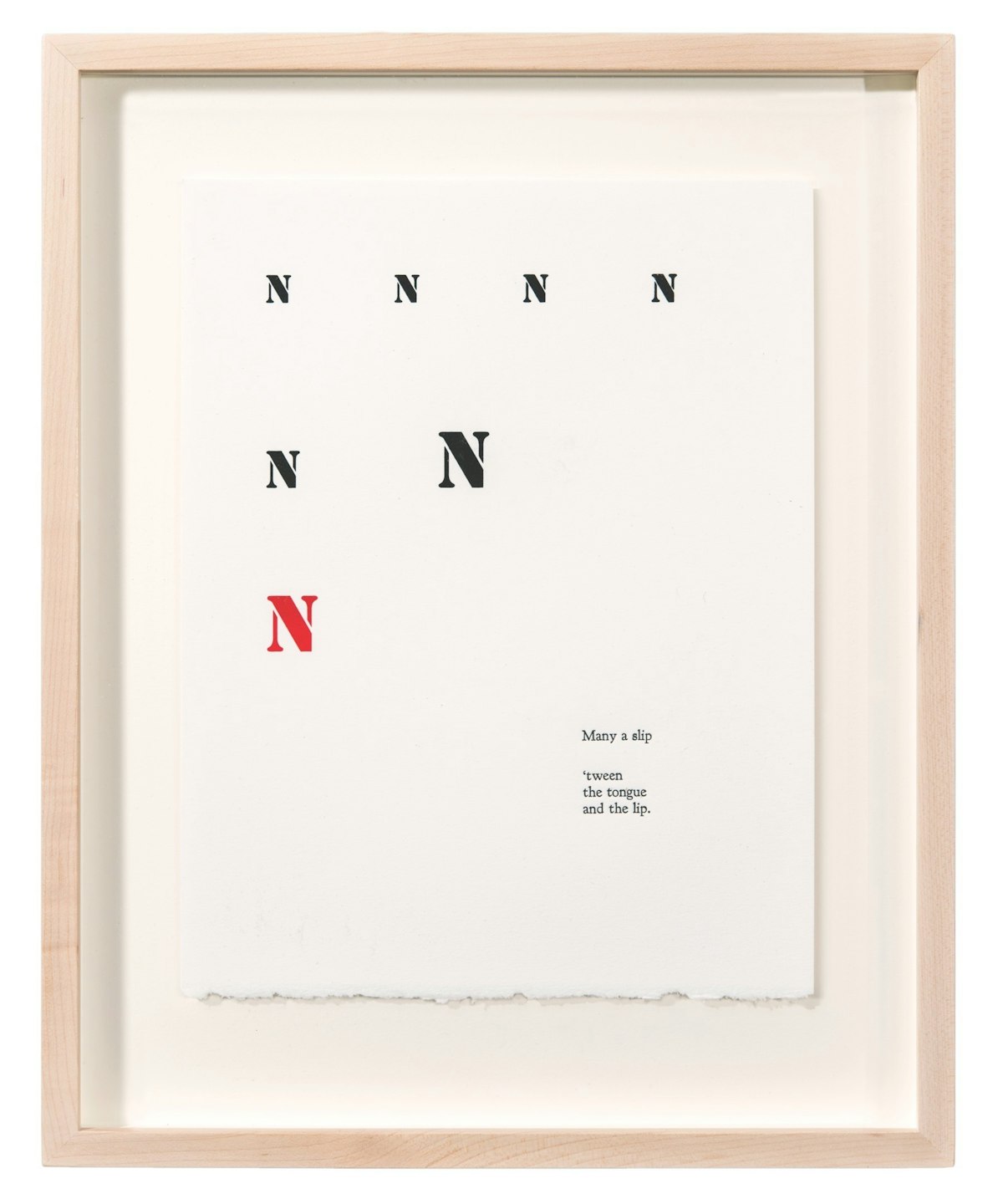
So what's at stake in these codes is in part a shared identity, something comprising an “inside” of a group as it names and determines itself. But there's also the “Thou art that” moment of an identity bestowed from the “outside.” And these moments are flipped, incorporated into each other.
Two sides of the same coin. I remember the first time I was made aware of my blackness, as a young child. It was at a swimming pool. I was so happy. The water was blue, and I climbed up onto the diving board and leaped off. You know, the pure joy that only a kid can have in a pool on a hot summer's day. Hit the water, PSHHHH!! and went under for a moment. As I came up and my head broke the surface, I heard two boys at the other end of the pool shouting at me, “Get out of the pool, you dirty nigger!” And I was just…the shock of the cold water, the shock of those cold words. That was the first time I became aware of an outside perception of my blackness. Nobody ever talks about those times. Nobody ever talks about the first time you realized that you were white or the first time you realized you were a girl and not a boy. Those are profound psychological experiences. Pool expresses my first realization that others see me differently than who I am.
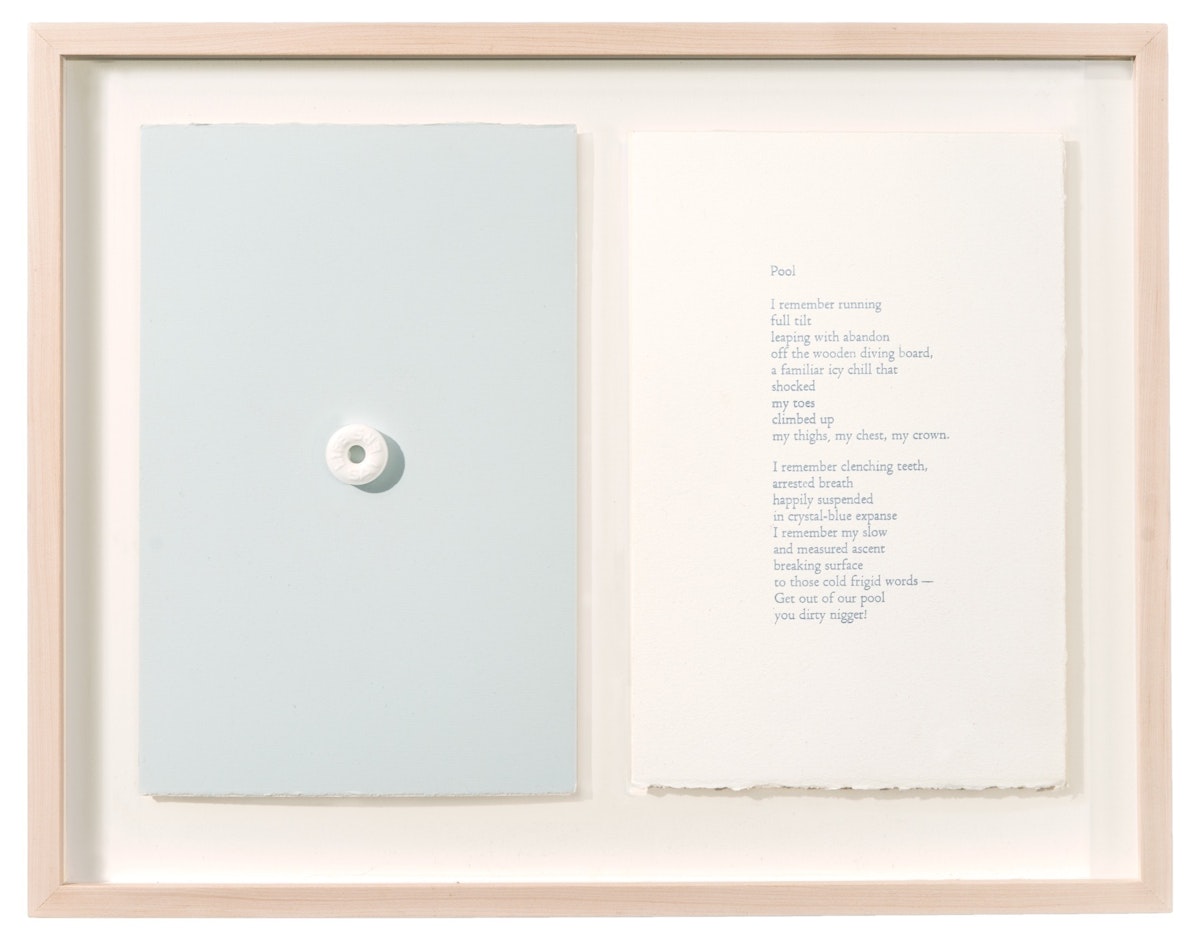
I've had my moments, too. We're all somebody's other.
You mentioned the word “nigger” before, it seemed you wanted to rename it entirely, or displace it. “The N-word” is so weird and uncomfortable; it grants power to “nigger” by highlighting its absence. But how do we not reckon with it? And then, how do we? “Nigger” is a killer word — I mean literally, it kills — but it's also a name of highest praise. Again, who can and can't use it? Even “black” is uncomfortable — I've seen many white students lower their voices when they refer to “black” people, because they know that word's loaded, too, and they don't want to cause hurt. But black, I tell them, is a glorious term — use it! It harbors an entire spectrum of meanings, extending way beyond that… unspeakable negation of white. In a way, black is the ever-increasing sum of all its uses, ongoing from moment to moment.
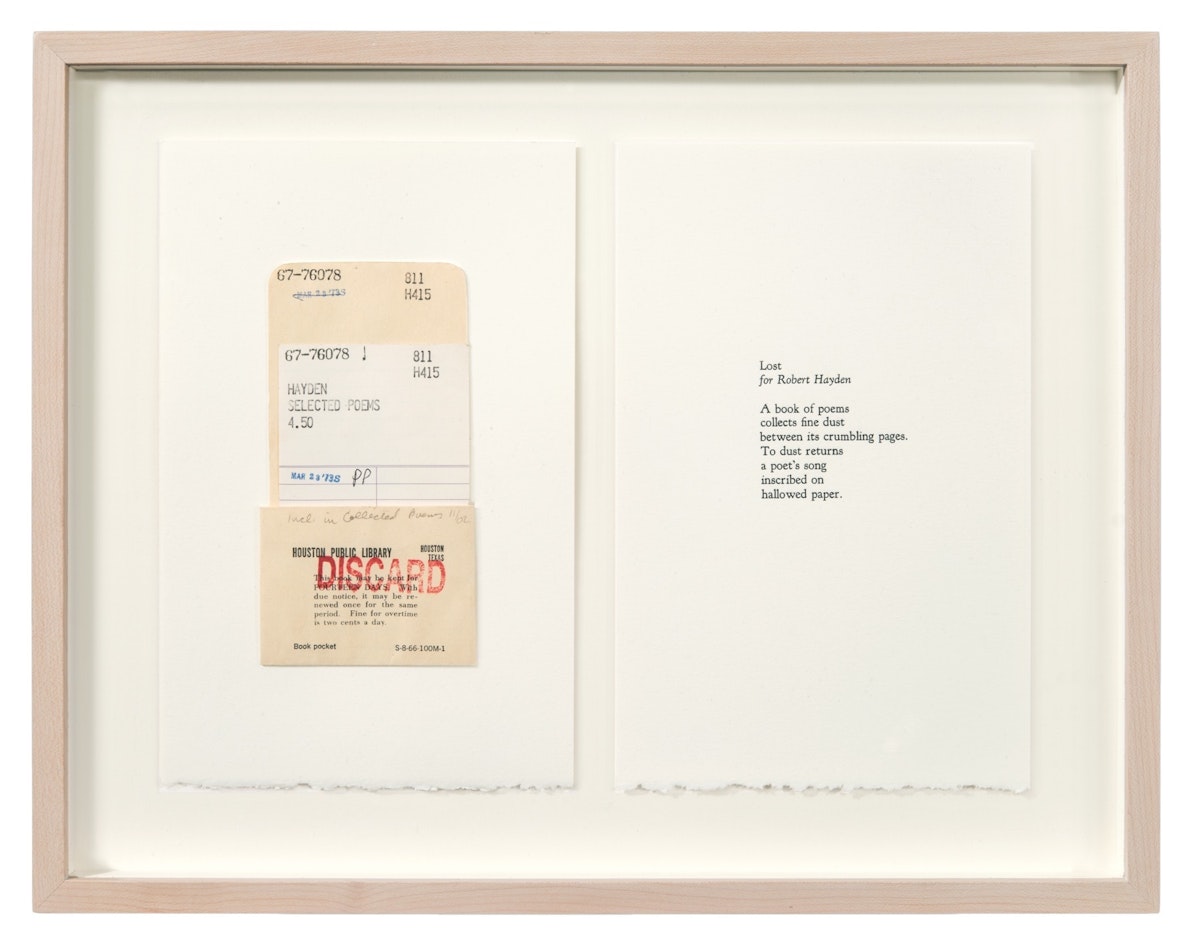
Your work seems to address this spectral aspect of black, its multiplicity. You code it and empower it through red, which Levi-Strauss called “the supreme presence of color,” the color of blood and fire, and of suffering, too. So these pure blacks and reds come to imbue each other, multiplying possibilities way beyond Rembrandt's twenty-four blacks.
That's where it really begins for me. My hope is that the Color Code exhibition creates a space for people to consider the blessings and baggage of heritage and skin color. I'm asking them to think critically about race, and about the structures — social, political, educational, environmental, etc.— that create, perpetuate, and manage society through an unbalanced distribution of wealth, power, and opportunity. And I want people to think creatively about how to shift this dynamic.
Amen to that.
Thanks, Marianetta.
Interview by David T. Doris.
Title Image: Marianetta Porter, Presence of Absence II (Am I a Figment of Your Imagination?), 2013.
Footnotes
- Hélène Cixous, “Bathsheba or the Interior Bible,“ in Stigmata, trans. Catherine A. F. MacGillivray (New York and London: Routledge, 1998), 4.
- Robert Douglas, “Formalizing an African-American Aesthetic,“ New Art Examiner 18 (1991):18–24.
- Zora Neale Hurston, “Characteristics of Negro Expression,“ in Negro: An Anthology, ed. Nancy Cunard (London: Wishart, 1934), 39–46.
- Richard Alan Waterman, “African Influence on the Music of the Americas,“ in Acculturation in the Americas, ed. Sol Tax (Chicago: University of Chicago Press, 1952), 81–94.
- Robert Farris Thompson, Flash of the Spirit: African and Afro-American Art and Philosophy (New York: Vintage, 1983), xiii.
- Michelle M. Wright, Physics of Blackness: Beyond the Middle Passage Epistemology (Minneapolis: University of Minnesota, 2015).
- Touré, Who’s Afraid of Post-Blackness?: What It Means to Be Black Now (New York: Free Press, 2011).
- Henry Louis Gates, “In the Kitchen,“ New Yorker, April 18, 1994, 82–86.